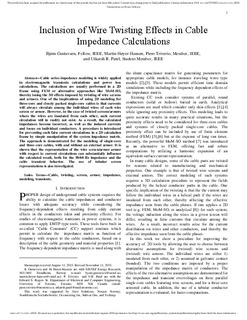| dc.contributor.author | Gustavsen, Bjørn Alfred | |
| dc.contributor.author | Høyer-Hansen, Martin | |
| dc.contributor.author | Triverio, Piero | |
| dc.contributor.author | Patel, Utkarsh R. | |
| dc.date.accessioned | 2017-01-18T15:01:04Z | |
| dc.date.available | 2017-01-18T15:01:04Z | |
| dc.date.created | 2016-12-08T14:54:54Z | |
| dc.date.issued | 2016 | |
| dc.identifier.citation | IEEE Transactions on Power Delivery. 2016, 31 (6), 2520-2529. | nb_NO |
| dc.identifier.issn | 0885-8977 | |
| dc.identifier.uri | http://hdl.handle.net/11250/2427722 | |
| dc.description.abstract | Cable-series impedance modeling is widely applied in electromagnetic transients simulations and power-loss calculations. The calculations are usually performed in a 2-D frame using the finite-element method or alternative approaches, such as MoM-SO, thereby losing the 3-D effects imposed by twisting wire screens and armors. One of the implications of using 2-D modeling for three-core and closely packed single-core cables is that currents will always circulate among the individual wires of each wire screen or armor. However, in the case of twisted screens/armors where the wires are insulated from each other, such current circulation will in reality not exist. As a result, the calculated impedances become incorrect as well as the induced currents and losses on individual conductors. A procedure is introduced for preventing such false current circulations in a 2-D calculation frame by simple manipulation of the system impedance matrix. The approach is demonstrated for the modeling of single-core and three-core cables, with and without external armor. It is shown that the representation of the wire screen/armor armor with respect to current circulations can substantially influence the calculated result, both for the 50/60 Hz impedance and the cable transient behavior. The use of tubular screen representations is also investigated | nb_NO |
| dc.language.iso | eng | nb_NO |
| dc.title | Inclusion of Wire Twisting Effects in Cable Impedance Calculations | nb_NO |
| dc.type | Journal article | nb_NO |
| dc.type | Peer reviewed | nb_NO |
| dc.rights.holder | IEEE | nb_NO |
| dc.source.pagenumber | 2520-2529 | nb_NO |
| dc.source.volume | 31 | nb_NO |
| dc.source.journal | IEEE Transactions on Power Delivery | nb_NO |
| dc.source.issue | 6 | nb_NO |
| dc.identifier.doi | 10.1109/TPWRD.2016.2531125 | |
| dc.identifier.cristin | 1410311 | |
| cristin.unitcode | 7548,50,0,0 | |
| cristin.unitcode | 7548,30,0,0 | |
| cristin.unitname | Energisystemer | |
| cristin.unitname | Elkraftteknologi | |
| cristin.ispublished | true | |
| cristin.fulltext | original | |
| cristin.qualitycode | 2 | |
